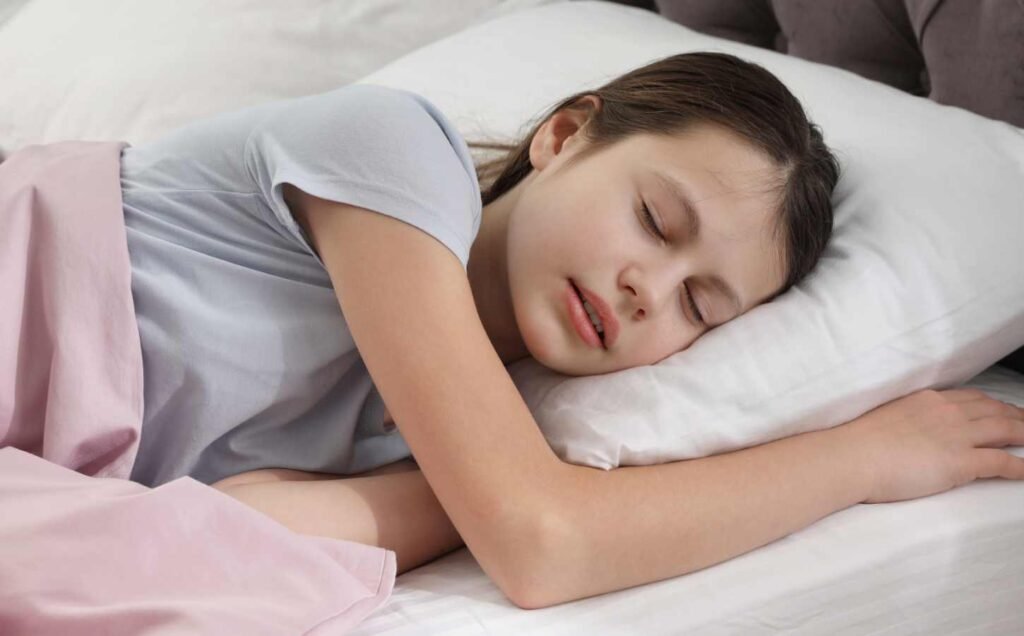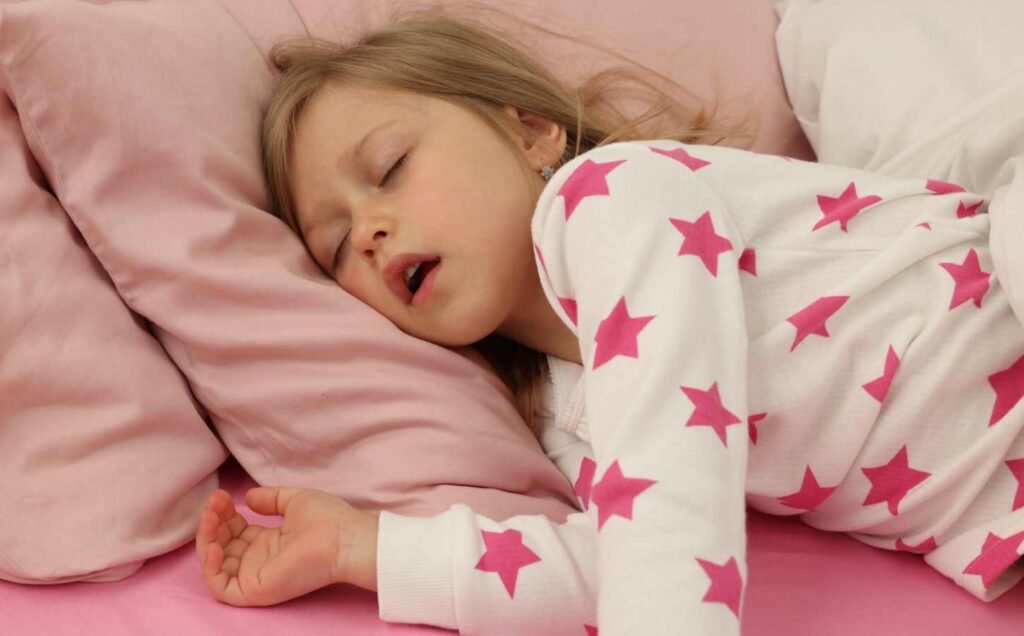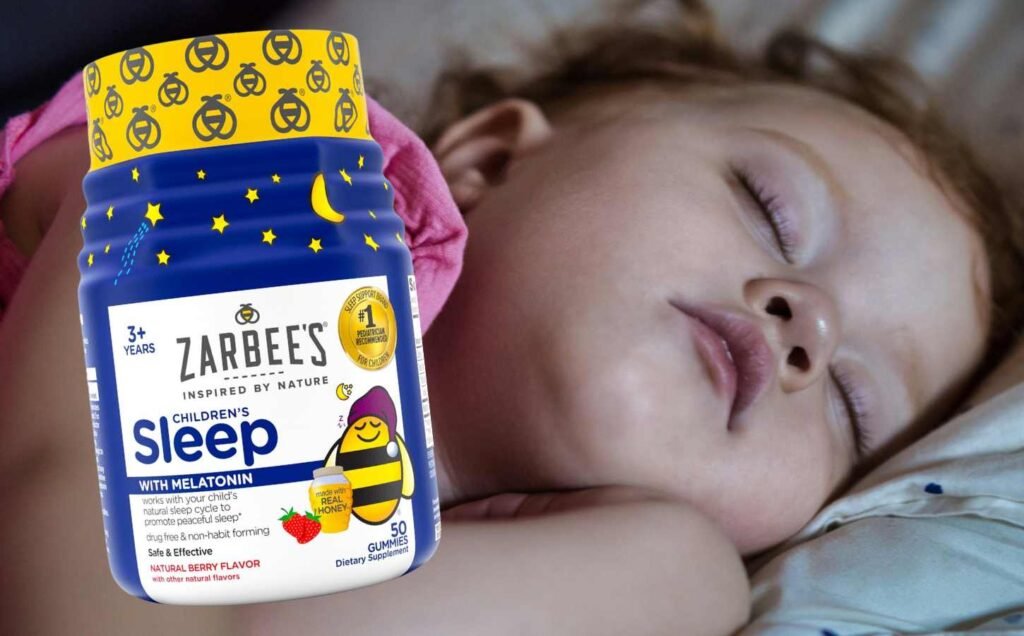Sleep Disordered Breathing in Children is a common condition among children that can have a significant impact on their health and well-being.
Sleep disordered breathing (SDB) refers to a group of disorders that affect breathing during sleep, including snoring, obstructive sleep apnea, and other forms of sleep-related breathing disorders. These conditions can lead to a variety of problems, including poor sleep quality, daytime sleepiness, behavior and learning problems, and even developmental delays.
Children are particularly vulnerable to SDB because their airways are smaller and more prone to obstruction than those of adults. In addition, children who have enlarged tonsils or adenoids, or who are overweight or obese, are at increased risk of developing SDB.
It is estimated that up to 10% of children may have some form of SDB, although many cases go undiagnosed and untreated. As a result, it is important for parents and healthcare providers to be aware of the signs and symptoms of SDB and to seek appropriate evaluation and treatment when necessary.
Understanding Sleep Disordered Breathing
Defining Sleep Disordered Breathing
Sleep disordered breathing is a term used to describe a range of breathing disorders that occur during sleep. It is a common condition that affects both adults and children. Sleep Disordered Breathing in children is characterized by partial or complete obstruction of the upper airway during sleep, leading to disrupted breathing patterns, decreased oxygen levels, and fragmented sleep.
Types of Pediatric Sleep Disordered Breathing
Pediatric Sleep Disordered Breathing can be broadly classified into two types: obstructive sleep apnea (OSA) and primary snoring. OSA is the most severe form of sleep disordered breathing in children and is characterized by complete obstruction of the upper airway during sleep, resulting in cessation of breathing for at least 10 seconds. Primary snoring, on the other hand, is characterized by loud snoring without any associated breathing difficulties.
Prevalence and Epidemiology
Pediatric Sleep Disordered Breathing is a common condition, with an estimated prevalence of 1-5% in children aged 2-8 years. The prevalence of SDB increases with age, with up to 10% of children aged 8-11 years affected. Boys are more likely to be affected than girls, with a male-to-female ratio of 2:1. Other risk factors for Sleep Disordered Breathing in children include obesity, craniofacial abnormalities, and neuromuscular disorders.
In summary, sleep disordered breathing in children is a common condition that can have significant health consequences if left untreated. It is important for parents and healthcare providers to be aware of the signs and symptoms of SDB and seek appropriate medical attention if necessary.
Causes and Risk Factors
Sleep disordered breathing in children is a complex disorder that can be caused by a variety of factors. While some children may have only one cause, most have a combination of factors that contribute to their SDB.
Anatomical Factors
Anatomical factors such as enlarged tonsils and adenoids, a narrow airway, or a small jaw can all contribute to Sleep Disordered Breathing in children. These factors can cause partial or complete obstruction of the airway during sleep, leading to snoring, gasping, and other breathing difficulties.
Obesity and Lifestyle
Obesity is a significant risk factor for Sleep Disordered Breathing in children. Excess weight can lead to the accumulation of fat around the neck and throat, which can narrow the airway and make breathing more difficult during sleep. In addition, sedentary lifestyles and poor sleep habits can also contribute to Sleep Disordered Breathing.
Genetic and Developmental Conditions
Certain genetic and developmental conditions can also increase a child’s risk for Sleep Disordered Breathing. Craniofacial syndromes, such as Down syndrome, can cause abnormalities in the development of the jaw, tongue, and airway, leading to Sleep Disordered Breathing. Morbid obesity can also be a contributing factor in children with these conditions.
Overall, Sleep Disordered Breathing in children is a complex disorder with multiple causes and risk factors. Identifying and addressing these factors is essential for effective treatment and management of the condition.
Signs and Symptoms
Common Symptoms of SDB in Children
Sleep disordered breathing in Children is a common condition that can cause a range of symptoms. One of the most common symptoms of Sleep Disordered Breathing is snoring, which can be loud and disruptive. Children with Sleep Disordered Breathing may also experience pauses in breathing during sleep, gasping or choking sounds, and restless sleep.
Behavioral and Developmental Impact
Sleep Disordered Breathing can also have a significant impact on a child’s behavior and development. Children with Sleep Disordered Breathing may experience daytime sleepiness, which can lead to poor school performance and behavioral issues. They may also have difficulty with attention and learning, and may experience developmental delays.
Complications and Associated Conditions
In addition to the immediate symptoms of SDB, the condition can also lead to a range of complications and associated conditions. Children with SDB are at increased risk of developing high blood pressure, heart disease, and other health problems. They may also be at increased risk of obesity, which can further exacerbate the symptoms of SDB.
Overall, it is important for parents and caregivers to be aware of the signs and symptoms of Sleep Disordered Breathing in children, and to seek medical attention if they suspect that their child may be suffering from the condition. With proper diagnosis and treatment, most children with SDB can experience significant improvement in their symptoms and quality of life.
Diagnosis and Assessment
Clinical Evaluation and History Taking
The diagnosis of sleep disordered breathing in children requires a thorough clinical evaluation and history taking. Physicians should obtain a detailed history of the child’s sleep habits and symptoms, as well as any relevant medical history. Parental observations are also crucial in identifying potential sleep-related issues in children.
Physical Examination and ENT Assessment
A physical examination is an essential part of the assessment of children with sleep disordered breathing. An otolaryngologist should perform a comprehensive evaluation of the upper airway and assess for any abnormalities that may contribute to the child’s symptoms. The assessment may include a nasal endoscopy or flexible laryngoscopy to visualize the airway.
Polysomnography and Other Diagnostic Tests
Polysomnography (PSG) is the gold standard for the diagnosis of sleep disordered breathing in children. PSG is an objective test that measures various physiological parameters during sleep, including airflow, respiratory effort, oxygen saturation, and sleep architecture. PSG is usually performed in a hospital or sleep laboratory setting.
Other diagnostic tests, such as home sleep testing or overnight oximetry, may be used in certain situations. However, these tests are not as comprehensive as PSG and may not provide enough information to make a definitive diagnosis of sleep disordered breathing.
In conclusion, the diagnosis and assessment of sleep disordered breathing in children require a comprehensive evaluation that includes a detailed history, physical examination, and objective testing. PSG is the gold standard for diagnosis, but other tests may be used in certain situations. Physicians should work closely with parents and other healthcare professionals to ensure an accurate diagnosis and appropriate treatment plan.
Treatment and Management
Sleep disordered breathing in children can be effectively managed with a variety of treatment options. The appropriate treatment plan depends on the underlying cause, severity, and individual needs of the child. This section outlines the most common treatment options for SDB in children and their management strategies.
Non-Surgical Interventions
Non-surgical interventions are often the first line of treatment for mild to moderate SDB in children. These interventions include:
- Weight loss: Obesity is a significant risk factor for SDB. Encouraging children to maintain a healthy weight can help reduce the severity of SDB.
- Lifestyle changes: Simple changes such as sleeping on the side, avoiding allergens, and maintaining good sleep hygiene can improve SDB symptoms.
- Intranasal corticosteroids: These medications can help reduce inflammation in the nasal passages and improve airflow.
Surgical Treatments
Surgical treatments may be necessary for children with severe SDB or those who do not respond to non-surgical interventions. The most common surgical procedure for SDB in children is adenotonsillectomy, which involves removing the tonsils and adenoids. Other surgical options include:
- Uvulopalatopharyngoplasty (UPPP): This procedure involves removing excess tissue from the throat to widen the airway.
- Maxillomandibular advancement (MMA): This surgery moves the upper and lower jaws forward to increase the size of the airway.
Continuous Positive Airway Pressure Therapy
Continuous positive airway pressure (CPAP) therapy is a highly effective treatment for moderate to severe Sleep Disordered Breathing in children. CPAP therapy involves wearing a mask over the nose or mouth during sleep, which delivers a continuous stream of air to keep the airway open. CPAP therapy requires close monitoring and adjustments to ensure optimal treatment.
Lifestyle Changes and Adjunctive Therapies
In addition to medical interventions, lifestyle changes and adjunctive therapies can help manage SDB in children. These include:
- Management strategies for enuresis (bedwetting): Addressing bedwetting can improve sleep quality and reduce the severity of SDB.
- Management of metabolic disorders: Children with metabolic disorders such as obesity, diabetes, and hypothyroidism may require specific management strategies to manage SDB.
Long-term health outcomes for children with Sleep Disordered Breathing can be improved with appropriate treatment and management. It is essential for healthcare providers and caregivers to work together to develop a comprehensive treatment plan that addresses the individual needs of the child.
Monitoring and Long-Term Considerations
Follow-Up and Longitudinal Studies
Children with sleep disordered breathing require long-term monitoring to ensure that their condition is properly managed. Follow-up studies are essential to determine the effectiveness of treatment and to identify any potential complications. Longitudinal studies are also important to understand the long-term effects of SDB on a child’s health.
Monitoring of Sleep disordered breathing in children can be done through various methods, including polysomnography (PSG), which measures brain waves, eye movement, muscle tension, and level of oxygen in the blood. PSG is considered the gold standard for diagnosing SDB and monitoring treatment effectiveness. However, PSG can be painful and uncomfortable for children, and inaccurate results can occur due to movement during sleep.
Other monitoring methods include home sleep studies, which can be less invasive and more convenient for families. These studies typically measure breathing patterns, heart rate, and oxygen levels. However, they may not provide as much information as PSG.
Impact on Long-Term Health Outcomes
SDB can have significant impacts on a child’s long-term health outcomes, including developmental issues and cardiovascular disease. Children with SDB may have difficulty concentrating and may experience mood changes, which can affect their academic performance and social interactions.
Research suggests that SDB may also increase the risk of developing cardiovascular disease later in life. This is because SDB can cause changes in blood pressure and heart rate, which can lead to damage to the cardiovascular system over time.
Educating Parents and Caregivers
Parents and caregivers play a critical role in the management of Sleep Disordered Breathing in children. It is important for them to understand the signs and symptoms of SDB and to seek medical attention if they suspect their child may have the condition.
Parents and caregivers should also be educated on the importance of treatment and monitoring of SDB. They should be aware of the potential long-term health impacts of untreated SDB and the importance of following up with a specialist to ensure proper management of the condition.
In conclusion, monitoring and long-term considerations are crucial in the management of Sleep Disordered Breathing in children. Follow-up and longitudinal studies are important for determining treatment effectiveness and identifying potential complications. SDB can have significant impacts on a child’s long-term health outcomes, and educating parents and caregivers is essential for proper management of the condition.
Frequently Asked Questions
What are the common symptoms of sleep-disordered breathing in children?
The common symptoms of sleep-disordered breathing in children include snoring, gasping, or choking during sleep, restless sleep, difficulty breathing, mouth breathing, and sweating during sleep. Children with sleep-disordered breathing may also experience daytime sleepiness, irritability, and difficulty concentrating.
How is sleep-disordered breathing treated in pediatric patients?
The treatment for sleep-disordered breathing in pediatric patients depends on the severity of the condition. Mild cases may be managed with lifestyle changes such as weight loss, avoiding alcohol and sedatives, and sleeping on the side. Moderate to severe cases may require continuous positive airway pressure (CPAP) therapy, oral appliances, or surgery.
What behavioral changes might indicate a child has sleep apnea?
Behavioral changes that may indicate a child has sleep apnea include difficulty paying attention, hyperactivity, aggression, and mood swings. Children with sleep apnea may also experience academic difficulties and show signs of depression.
How prevalent is sleep-disordered breathing among children?
Sleep-disordered breathing is a common condition among children. It is estimated that up to 10% of children snore regularly, and 1-3% of children have obstructive sleep apnea.
What should I do if my child gasps for air or breathes irregularly during sleep?
If your child gasps for air or breathes irregularly during sleep, it is important to consult a healthcare provider. Your child may need to undergo a sleep study to determine the cause of the breathing disturbance and the appropriate treatment.
Are infants at risk for sleep-disordered breathing, and how is it identified?
Infants are at risk for sleep-disordered breathing, especially if they were born prematurely or have a history of respiratory problems. Sleep-disordered breathing in infants may be identified by symptoms such as snoring, pauses in breathing, and difficulty feeding. It is important to consult a healthcare provider if you suspect your infant has sleep-disordered breathing.
Pediatric Sleep Apnea: Causes, Symptoms, and Treatment Options

Pediatric sleep apnea is a sleep disorder that causes a child to stop breathing repeatedly during sleep. This condition occurs when the muscles in the back of the throat fail to keep the airway open, leading to a blockage in the air passage. The child may snore loudly, gasp, or choke during sleep, and may also experience disrupted sleep, leading to daytime sleepiness and other complications.
Continue reading: Pediatric Sleep Apnea
Does My Child Have Sleep Apnea Quiz: Recognizing Daytime and Nighttime Signs

Parents may wonder if their child has sleep apnea and may be unsure of how to recognize the symptoms. One way to determine if a child has sleep apnea is by taking a sleep apnea quiz. This quiz can help parents identify some of the common symptoms of sleep apnea in children, such as snoring, gasping or choking during sleep, and daytime sleepiness.
Continue reading: Does My Child Have Sleep Apnea Quiz
Zarbee’s Kids Melatonin Sleep Gummies for Toddlers*
Are you a parent struggling to get your child to sleep at night? We’ve recently tried out Zarbee’s Kids 1mg Melatonin Sleep Gummies for toddlers, and we’re impressed with the results.
One of the best features of Zarbee’s Kids 1mg Melatonin Gummy* is that it’s pediatrician-approved. The brand was developed by a father and pediatrician, Dr. Zak Zarbock, and has become the #1 Pediatrician Recommended Sleep Support Brand for Children.
*As an Amazon.com Affiliate, we may earn a small commission if you buy from a link within this page.




